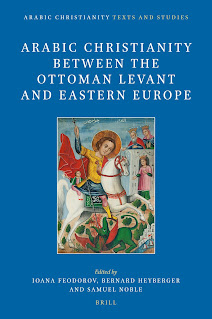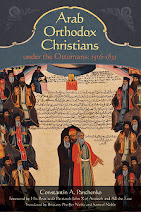This was published some months ago, but it only came to my attention today. For another, more scholarly review by Heleen Murre-van den Berg see here. For the original of Fr Babcock's review, see pp. 34 and 36 of the January 2017 issue of the Melkite Catholic Eparchy of Newton's journal Sophia, here.
Book Review: Arab Orthodox Christians under the Ottomans
by Archimandrite James Babcock
Admittedly I was both intrigued and suspicious when I saw the title and then the publisher of Arab Orthodox Christians under the Ottomans: 1516-1831 by Constantin A. Panchenko. This book lifts the veil covering the hidden years of the Patriarchate of Antioch during Ottoman rule in Lebanon/Syria, Palestine, Jordan, and Egypt.
What seemed suspicious was the publisher: Holy Trinity Seminary Press, Jordanville, New York. This monastery is under the jurisdiction of the Russian Orthodox Church outside Russia, the most traditional (and anti-Catholic) part of the Russian Church. I suspected a possibly slanted report.
Yet as I began to read, I quickly discovered that this tale would be reported with an even and balanced hand. To a Melkite, the chapter of greatest interest was “The Catholic Unia,” covering the time of the unfortunate division of the Patriarchate of Antioch in 1724. The author’s impeccable research brings to life the events of those heady days and the regrettable and pretty much unnecessary hostility that arouse out of those events.
To quote the author, “It was a time of active economic and religious expansion of the Catholic world in the Levant [and] was one of the key periods in the history of the Christian East . . . leading to a dramatic rift in the Middle Eastern communities.” Panchenko chronicles the events and activities of the Roman (Latin) Catholic Church among the Melkites.
It should be noted that the term “Melkite” originally referred to all Orthodox Christians in the Middle East. In this sense “Melkite” and “Orthodox” are synonymous. After the division, the term “Melkite” was appropriated by the members of the Antiochian Patriarchate who entered into communion with the Church of Rome. This mixing of names can be a bit confusing as one reads the history of the events.
Panchenko paints a portrait of the sorry state of the Church of Antioch as well as the other Patriarchates (Jerusalem and Alexandria), which did vary from Church to Church, each Church’s circumstances being somewhat different. The bulk of the story, however, unfolds in the Patriarchate of Antioch, a Church already weakened by divisions in earlier centuries.
The history begins with the Arab conquest and the life of the Christians under the Umayyad Caliphate in the sixth century and the fading inertia of the Byzantine culture. In the early years, the culture of the Melkites continued as before; however, when the situation began to deteriorate, the Christians revolted, which resulted in harsher conditions for them. Collection of the jizya tax became more exacting and Christian civil servants were dismissed. A catastrophic earthquake added to the suffering. From the ninth to the eleventh century the Middle East entered into what some historians call “the dark ages.” During this time the “Arabization” of the
Melkites began to take place. Christian scholars began to write in Arabic, and Arabic began to creep into the celebration of the divine services, replacing the traditional Greek.
As the Islamic dynasties shifted from the Abbasid to the Fatimid, for a brief time Byzantine influence began to re-assert itself. This influence ended abruptly with the rise of the Caliph al-Hakim. Severe persecution broke out, resulting in the destruction of the churches and the hierarchy. In Egypt only one Melkite bishop survived.
Soon a new challenge arose for the Melkites—the Crusades. The balance of power shifted from Islamic to Western (Latin) Christianity. Antioch was captured and later Jerusalem. The Latins installed bishops and patriarchs who replaced the Melkite bishops.
With the defeat of the Crusader empire and the rise of the Ottoman empire, the fate of the Christians of the Middle East shifted again. The Ottomans did not try to change the traditional way of life of the population but instead established various means to control it. This resulted in the establishment of the Millet system, wherein each ethnic or religious group was given broad governing powers over its own people with the provision that the leaders pay the jizya, which kept increasing year after year.
Now the spiritual leaders of the church also became civil leaders. This also increased the role of the laity in the governance of the church. Geographical demographics also played a role in the development of the churches. Mount Lebanon became a Christian reserve during this time. Panchenko thoroughly examines the role of the shepherds and their flocks.
A chapter on the role and importance of monasteries and monasticism adds depth to the understanding of the powerful influence they exerted on the life of the church. Here we begin to see the origins of how the division of the Patriarchate of Antioch began.
The author shows the origins of the struggles over the Holy Places of Jerusalem and Bethlehem and the despicable fights that would break out between the monks and spiritual leaders. The chapter on foreign relations shows the beginning of the powerful influence of the Russian Church.
Finally, we arrive at the time of the division of the Patriarch of Antioch into Catholic and Orthodox jurisdictions. Many ugly events unfold and the reader begins to see that this is more of a power struggle, highly influenced by a desire for a more comfortable life which European culture could provide, than a dispute over any kind of ecclesiastical or theological differences.
A brief historical summary, maps, and photos are included. Arab Orthodox Christians under the Ottomans: 1516-1831 is a must-read for all who love the Antiochian church and who lament its regrettable division. Knowledge brings understanding and wisdom, two elements required for the re-establishment and reunion of our church, Melkite and Orthodox.
Book Review: Arab Orthodox Christians under the Ottomans
by Archimandrite James Babcock
Admittedly I was both intrigued and suspicious when I saw the title and then the publisher of Arab Orthodox Christians under the Ottomans: 1516-1831 by Constantin A. Panchenko. This book lifts the veil covering the hidden years of the Patriarchate of Antioch during Ottoman rule in Lebanon/Syria, Palestine, Jordan, and Egypt.
What seemed suspicious was the publisher: Holy Trinity Seminary Press, Jordanville, New York. This monastery is under the jurisdiction of the Russian Orthodox Church outside Russia, the most traditional (and anti-Catholic) part of the Russian Church. I suspected a possibly slanted report.
Yet as I began to read, I quickly discovered that this tale would be reported with an even and balanced hand. To a Melkite, the chapter of greatest interest was “The Catholic Unia,” covering the time of the unfortunate division of the Patriarchate of Antioch in 1724. The author’s impeccable research brings to life the events of those heady days and the regrettable and pretty much unnecessary hostility that arouse out of those events.
To quote the author, “It was a time of active economic and religious expansion of the Catholic world in the Levant [and] was one of the key periods in the history of the Christian East . . . leading to a dramatic rift in the Middle Eastern communities.” Panchenko chronicles the events and activities of the Roman (Latin) Catholic Church among the Melkites.
It should be noted that the term “Melkite” originally referred to all Orthodox Christians in the Middle East. In this sense “Melkite” and “Orthodox” are synonymous. After the division, the term “Melkite” was appropriated by the members of the Antiochian Patriarchate who entered into communion with the Church of Rome. This mixing of names can be a bit confusing as one reads the history of the events.
Panchenko paints a portrait of the sorry state of the Church of Antioch as well as the other Patriarchates (Jerusalem and Alexandria), which did vary from Church to Church, each Church’s circumstances being somewhat different. The bulk of the story, however, unfolds in the Patriarchate of Antioch, a Church already weakened by divisions in earlier centuries.
The history begins with the Arab conquest and the life of the Christians under the Umayyad Caliphate in the sixth century and the fading inertia of the Byzantine culture. In the early years, the culture of the Melkites continued as before; however, when the situation began to deteriorate, the Christians revolted, which resulted in harsher conditions for them. Collection of the jizya tax became more exacting and Christian civil servants were dismissed. A catastrophic earthquake added to the suffering. From the ninth to the eleventh century the Middle East entered into what some historians call “the dark ages.” During this time the “Arabization” of the
Melkites began to take place. Christian scholars began to write in Arabic, and Arabic began to creep into the celebration of the divine services, replacing the traditional Greek.
As the Islamic dynasties shifted from the Abbasid to the Fatimid, for a brief time Byzantine influence began to re-assert itself. This influence ended abruptly with the rise of the Caliph al-Hakim. Severe persecution broke out, resulting in the destruction of the churches and the hierarchy. In Egypt only one Melkite bishop survived.
Soon a new challenge arose for the Melkites—the Crusades. The balance of power shifted from Islamic to Western (Latin) Christianity. Antioch was captured and later Jerusalem. The Latins installed bishops and patriarchs who replaced the Melkite bishops.
With the defeat of the Crusader empire and the rise of the Ottoman empire, the fate of the Christians of the Middle East shifted again. The Ottomans did not try to change the traditional way of life of the population but instead established various means to control it. This resulted in the establishment of the Millet system, wherein each ethnic or religious group was given broad governing powers over its own people with the provision that the leaders pay the jizya, which kept increasing year after year.
Now the spiritual leaders of the church also became civil leaders. This also increased the role of the laity in the governance of the church. Geographical demographics also played a role in the development of the churches. Mount Lebanon became a Christian reserve during this time. Panchenko thoroughly examines the role of the shepherds and their flocks.
A chapter on the role and importance of monasteries and monasticism adds depth to the understanding of the powerful influence they exerted on the life of the church. Here we begin to see the origins of how the division of the Patriarchate of Antioch began.
The author shows the origins of the struggles over the Holy Places of Jerusalem and Bethlehem and the despicable fights that would break out between the monks and spiritual leaders. The chapter on foreign relations shows the beginning of the powerful influence of the Russian Church.
Finally, we arrive at the time of the division of the Patriarch of Antioch into Catholic and Orthodox jurisdictions. Many ugly events unfold and the reader begins to see that this is more of a power struggle, highly influenced by a desire for a more comfortable life which European culture could provide, than a dispute over any kind of ecclesiastical or theological differences.
A brief historical summary, maps, and photos are included. Arab Orthodox Christians under the Ottomans: 1516-1831 is a must-read for all who love the Antiochian church and who lament its regrettable division. Knowledge brings understanding and wisdom, two elements required for the re-establishment and reunion of our church, Melkite and Orthodox.








No comments:
Post a Comment